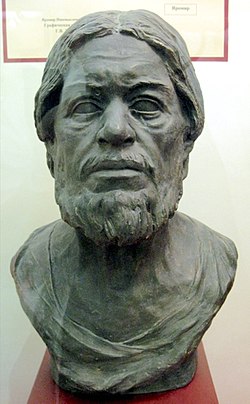Tsar Samoil
| Samuel Самуил |
|
|---|---|
| Tsar of Bulgaria | |

reconstruction
|
|
| Reign | 997 – 6 October 1014 |
| Predecessor | Roman |
| Successor | Gavril Radomir |
| Died | 6 October 1014 Prespa,First Bulgarian Empire (unknown town located in the border-area of Prespa, shared between modern-day Macedonia, Albania and Greece) |
| Burial | Island Saint Achillios in the Small Prespa Lake, First Bulgarian Empire (modern-day Greece) |
| Spouse | Agatha |
| Issue | Gavril Radomir Miroslava |
| Dynasty | Cometopuli |
| Father | Nicholas |
| Mother | Ripsimia of Armenia |
| Religion | Bulgarian Orthodox |
Samuel (also Samuil, representing Bulgarian Самуил, pronounced [samuˈil]) was the Tsar (Emperor) of the First Bulgarian Empire from 997 to 6 October 1014. From 977 to 997, he was a general under Roman I of Bulgaria, the second surviving son of Emperor Peter I of Bulgaria, and co-ruled with him, as Roman bestowed upon him the command of the army and the effective royal authority. As Samuel struggled to preserve his country's independence from the Byzantine Empire, his rule was characterized by constant warfare against the Byzantines and their equally ambitious ruler Basil II.
In his early years Samuel managed to inflict several major defeats on the Byzantines and to launch offensive campaigns into their territory. In the late 10th century, the Bulgarian armies conquered the principality of Duklja and led campaigns against the Kingdoms of Croatia and Hungary. But from 1001, he was forced mainly to defend the Empire against the superior Byzantine armies. Samuel died of a heart attack on 6 October 1014, two months after the catastrophic battle of Kleidion. His successors failed to organize a resistance, and in 1018, four years after Samuel's death, the country capitulated, ending the five decades-long Byzantine–Bulgarian conflict.
Samuel was considered "invincible in power and unsurpassable in strength". Similar comments were made even in Constantinople, where John Kyriotes penned a poem offering a punning comparison between the Bulgarian Emperor and Halley's comet, which appeared in 989.
...
Wikipedia
